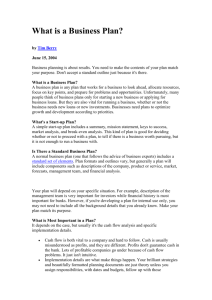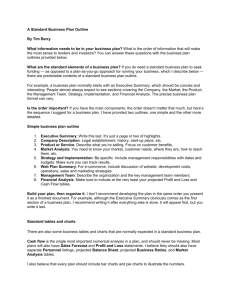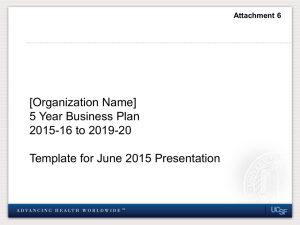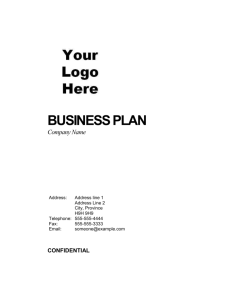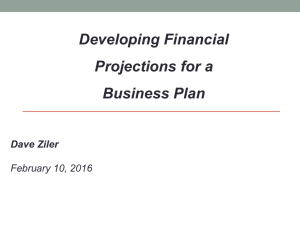WS4 - Financial Projections - Manasota Training
advertisement
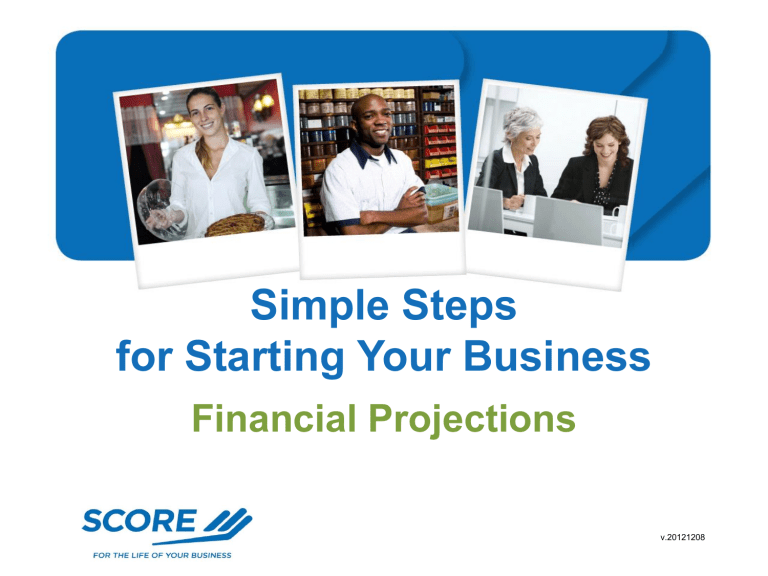
Simple Steps for Starting Your Business Financial Projections v.20121208 Simple Steps for Starting Your Business The SCORE Foundation would like to thank For showing their support of America’s small businesses by sponsoring this series. To learn more about Bank of America, visit: www.bankofamerica.com/smallbusiness/ www.score.org 2 A Special Thanks to Our Local Sponsors www.score.org 3 Classroom Safety – Argosy U Emergency Exits Restrooms Please do not wander around the building! You are HERE www.score.org 4 Classroom Safety–ComCenter Emergency Exits Restrooms You are HERE Please do not wander around the building! www.score.org 5 Simple Steps for Starting Your Business Session 4: Financial Plan & Projections www.score.org 6 Simple Steps Roadmap To Accelerate Your Success Session 1: Start-up Basics PERSONAL MENTORING Decide to Continue Session 2: Business Concept Session 3: Marketing Plan Session 4: Financial Projections Session 5: Funding Sources “GO OR NO GO” DECISION & NEXT STEPS WITH MENTOR www.score.org 7 Agenda • • • • • • Importance of financial planning Building your financial model Start-up funds Fixed operating expenses Forecasting sales units and prices Understanding financial statements: – Income statement – Cash flow statement – Balance sheet www.score.org 8 Introductions • Introductions • Name • Your business idea • What you hope to get out of this session • 30 seconds! www.score.org 9 Benefits of Financial Planning & Goal Setting • • • • Match business concept with personal income goals Gain a better understanding of financial risks and rewards Identify early development and start-up costs, ongoing operations expenses and funds needed to finance the business Have a plan to help guide business decisions and monitor results www.score.org 10 Why is a Financial Plan Important? • Helps you examine the feasibility of your numbers • Organizes your business finances • A modeling tool that helps you evaluate variable factors • A benchmark for tracking progress • A blueprint you can adjust to achieve your financial goals www.score.org 11 Financial Projection Model Common Concerns: • The spreadsheets look complicated. I don’t think I can do this on my own. • I don’t understand all the figures and math. • This is overwhelming. • Can I start my business without a financial projection model? Businesses don’t plan to fail – they often fail to plan! www.score.org 12 Simplified Statements Cash Flow www.score.org13 Financial Projection Model • Your work is SIMPLIFIED: 1 - Provide the INPUTS and update when required 2 –The RESULTS that are CALCULATED AUTOMATICALLY, so you need to learn where to look 3 – Determine if calculated forecast of cash flow, profit and loss and balance sheet information are acceptable for startup. • You DON’T need to know all the math • Work with your mentor on the forecasts. • Your accountant can provide ongoing advice. www.score.org14 Anne’s Nursery Example • Produces specimen trees, shrubs and vines • Projected third year sales: $710,000 • Sells to retail nurseries and end consumers • S-corporation www.score.org 15 Financial Model Template The first six worksheets are: 1. 2. 3. 4. 5. 6. Required Start-Up Funds Salaries and Wages Fixed Operating Expenses Projected Sales Forecast Projected Sales Forecast (2) Cash Receipts – Disbursements The remaining worksheets are calculated financial statements www.score.org 16 Need Software? The training templates are authored using Microsoft Word (word processor) Excel (spreadsheet) You DON’T need to know how to “program” spreadsheets, only how to fill in the data in the templates and find / use the results – all automatically calculated! If you already have and use the software– GREAT! If you do not have the software packages, there is an excellent FREE alternative that is compatible with Microsoft Office: Open Office - The Free and Open Productivity Suite Available for PC and Mac – Word Processor/ Spreadsheet / Presentation Download at: http://www.openoffice.org/ Documentation, if you need tutorials, etc: http://documentation.openoffice.org/ www.score.org17 SCORE Financial Projections Model SCORE Financial Projection Model Please read this entire page before you do anything else This spreadsheet walks you through the process of developing an integrated set of financial projections. To use this model, simply complete any information asked for found in the color yellow. Example: Fill in boxes that look like this A number found in the color green is optional information that you can complete. Example: Check these assumptions Otherwise, any information found in black type is automatically calculated for you. Although the cells that are calculated are locked (or protected), you can turn off this protection to modify the sheets. To do this, select "Tools" from the menu bar at the top of the screen. Then select, "Protection." Finally, select "Unprotect Sheet" and you will be able to edit any labels or formulas. Before you begin, we need some information about your business to best customize your financial statements. Please enter the name of your business in the box below: Anns Nursery The first six worksheets in this workbook are steps you will need to complete. They are titled: 1. Required Start-Up Funds 2. Salaries and Wages 3. Fixed Operating Expenses 4. & 5. Projected Sales Forecast (2 sheets) 6. Cash Receipts and Disbursements www.score.org18 Required Start-Up Funds How much do you need? What will it be used for? (Exercise 1a) • How much do you need? • What will it be used for? • This develops Assets part of opening Balance Sheet. www.score.org19 Sources of Funding • • • What are your expected sources of capital? Amount financed by owners vs. outside sources. Need to ensure funding exceeds start-up costs. www.score.org20 Salaries and Wages (Exercise 1b) www.score.org21 Exercise 1 a/b - Startup Expenses/Wages Worksheets 1 & 2 • Fifteen minute exercise: • Ten minutes worksheet 1 (1a) • Five minutes worksheet 2 (1b) – Fill in the quick data assumptions that apply to your business • Class discussion key concepts WS4 Financial Projections -Exercise 1a Startup Funds.xls WS4 Financial Projections -Exercise 1b Salaries and Wages.xls 60m www.score.org22 Fixed Operating Expenses • Depreciation expense is calculated based on inputs from tab one • Interest expense on debt capital is calculated from tab one and Cash Flow statements • Beware: Overwriting numbers in years 2 and 3 expense cells will overwrite formula (Exercise 2) www.score.org23 Exercise 2 -Fixed Operating Expenses Worksheet 3 • Ten-minute exercise: – Fill in quick data assumptions that apply to your business. • One-on-one Mentoring • Class review key concepts WS4 Financial Projections - Exercise 2 - Fixed Operating Expenses.xls 24 80m www.score.org Stretch Break 10 minutes, please 25 Forecasting Sales Units What unit categories make sense for your business? • You need to figure out if you’re selling: – Products – Services (hours or fixed price) – Combination (packages) • Determine what makes up your “unit of sale” • Determine your direct cost per unit • Determine your price per unit www.score.org 26 Sales Unit Data Sources Sales unit category or grouping • Product, service, package, volume, customer type Unit cost and price • Build up from sources • Subcontract • Competition Sales volume in units • Estimate from market • Competition • Number to make business profitable www.score.org 27 Product Producing Firm Ann’s Nursery has three categories of sale: 1. Direct to local retailers 2. Through representatives to distant retailers 3. Through internet-based sales to end consumers www.score.org 28 Unit of Sale Categories Think about: • What is your business? • What would be your units of sale categories? www.score.org29 Gross Profit Margin What is gross profit margin? – Sales ($) minus Cost of Goods Sold Why is it important? – Requires you to cost out what you’re selling – Helps you determine adequacy of gross price for what you’re selling www.score.org 30 Gross Profit Margin How much do you need & what will it be used for? Note: There are up to 4 supply chain or product types available to allow sales and fixed cost allocation segmentation 90m www.score.org31 Sales Approaches for Worksheet 4-5 Preferred forecasting approach “Unit sales price” and “unit cost” approach. vs. alternative “$1.00 price” and “percentage of sales” approach. www.score.org32 Projected Sales Forecast (Exercise 3) Forecast sales units by category: product, service or hours • Examples: – Retailer (products) – Hairdresser (service) – Computer repair (hours) 120m www.score.org33 Exercise 3 - Projected Sales Forecast Worksheet 4 • 10-minute Exercise: – Fill in the numbers (price, cost and volume) that apply to sales unit categories for your business. – Use sheet 4 for your first channel and sheet 5 for 2nd channel then build additional sheets, one per channel • One-on-one mentoring • Class review key concepts WS4 Financial Projections - Exercise 3 - Sales Forecast.xls www.score.org34 Resulting Financial Model Statements Remaining tabs in the spread sheet: • Income Statement • Cash Flow Statement • Balance Sheet • Financial Diagnostics • Year End Summary • Breakeven Analysis • Ratios 140m www.score.org35 Understanding Financial Statements Income Statement – Gross profit margin and overhead expense management Cash Flow Statement – Funds management Balance Sheet – Accounts Receivable (A/R), Inventory and Accounts Payable (A/P) management Breakeven Analysis Use of industry comparison ratios www.score.org 36 Why 3 Financial Statements? 1. Income statement – How long to reach profitability? – Do I make a profit or loss? 2. Cash flow statement – Do I have enough sources of funds to operate, sustain & grow the business? 3. Balance sheet – What are my assets & liabilities? – How much am I worth? These are Management Decision Tools that need frequent review! www.score.org 37 Income and Expense Statement Profit and Loss (P&L) Operating results for a period of time: • Sales • Expenses • Net Profit or Loss (“Bottom Line”) www.score.org38 Projected Income Statements: Part 1 160m www.score.org39 Projected Income Statements: Part 2 www.score.org40 Cash Flow Projection Cash Flow Statements Show: • Cash inflow and cash outflow • Like checkbook register • How much cash is generated and when • When cash is needed for major purchases • If enough cash is generated for loan payment www.score.org 41 Cash Flow Projection • • • Differs from income and P&L: – P&L reports billings and accrued expenses – Cash flow reports collections and payments Has cash payments for capital purchases and payments on loan principal: – The P&L does not show these Cash flow, sources and uses of funds are the most important documents in the loan package www.score.org 42 Projected Cash Flow Think about Accounts Receivable – will you collect everything? www.score.org43 Balance Sheet • Your financial position at a point in time (snapshot of the moving train) • What you own (assets) • What you owe (liabilities) • Your net worth (assets minus liabilities) www.score.org 44 Balance Sheet 180m www.score.org45 Pro Forma Balance Sheet 1 www.score.org46 Pro Forma Balance Sheet 2 www.score.org47 Break Even Analysis How many sales do you need to make, Sales at what price, at what costs and in Units to Reach Break Even Point what time period to be profitable? $10 ea - $ 5 ea = $ 5 ea (50%) Or $12,000 to $13,000 / .50 = $24,000 to $26,000 sales or about 2,400 to 2,600 items $40,000 $30,000 $20,000 $10,000 Units Sold x 100 Fixed Costs Fixed+ Semi Fixed Total Fixed + Variable Total Sales 51 46 41 36 31 26 21 16 11 $0 6 Break Even = Total fixed + semi fixed cost / %contribution margin $50,000 1 Fixed Costs $10,000 Semi Fixed Costs $2000-3000 Influenced by volume but not associated per unit (example – commission tiers, temporary labor, office supplies) $60,000 Dollars Example: Sales Price Variable Cost Contribution Margin Breakeven Analysis Breakeven, for a time period, is where: Gross Profit Margin $ = Total Expenses $ and Sales Volume = $0 Profit Breakeven Sales $ = Fixed Cost / %Gross Margin The spread between breakeven and sales forecast is very important (the wider the better) Ann does NOT reach breakeven this year! www.score.org 49 Break-even Estimate (divided by) 200m www.score.org50 Stretch Break 10 minutes, please 51 51 Benchmarking Benchmarking is: Comparing financial information to relevant information of a similar company or historical information of the industry norms. If you don’t know what the standard is you cannot compare yourself against it. 160m www.score.org52 Financial Research Resources • Risk Management Association (RMA) annual statement studies • Industry norms and key business ratios (Dun & Bradstreet) • Financial ratios, business statistics & benchmarks (www.BizStats.com) -FREE www.score.org53 Using Financial Ratios • RMA publishes average financial ratios for actual business results of thousands of different companies. You can find ratios in the Sarasota Selby library’s business section, your bank or SCORE. • Ratios help estimate both your first income statement and balance sheet. www.score.org54 Using Financial Ratios • Give you a quick check—and a reality check—on how you stack up against your peer companies in your industry. • Used by the bankers to test whether your business plan estimates are valid for your type of business. 220m www.score.org55 RMA % & Ratio Comparison Compare forecasted results to RMA data to review: • Strengths • Weaknesses • Opportunities for improvement • Threats www.score.org56 RMA % & Ratio Comparison www.score.org57 Review • • • • • • Importance of financial planning Building your financial model Start-up funds Fixed operating expenses Forecasting sales units and prices Understanding financial statements: – Income statement – Cash flow statement – Balance sheet www.score.org 58 Simple Steps for Starting Your Business Testing Your Business Ideas aSession 1 Start-up Basics aSession 2 Your Business Concept aSession 3 Marketing Plan aSession 4 Financial Projections Session 5 Funding Sources www.score.org 59 Homework Download documents at: http://www.score-suncoast.org/QSHandouts.aspx 1. Complete a rough draft of your input sheets from the exercises today 2. Put the values in the “QuickSTART Session 4 Financial Projections Template” – look at the resulting financial reports 3. Obtain your RMA ratio data. 4. See your SCORE mentor to finish your projections and help with the RMA data. 5. With the help of your mentor, you will be reviewing output sheets and modifying inputs several times before it makes sense. See you at the next session on Funding Sources www.score.org60 Need Help? • Manasota SCORE manasota.score.org • Ask SCORE for advice online: www.score.org/ask_score.html • Find a SCORE office near you: www.score.org/findscore Contact SCORE • Email SCORE: contact@score.org • Web Site: www.score.org 61 Help Us, Help You Please fill out the workshop evaluation form Your feedback is important to help us improve our programs! 62

